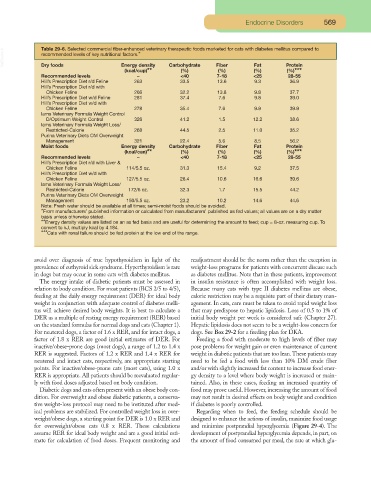Page 550 - Small Animal Clinical Nutrition 5th Edition
P. 550
Endocrine Disorders 569
VetBooks.ir Table 29-6. Selected commercial fiber-enhanced veterinary therapeutic foods marketed for cats with diabetes mellitus compared to
recommended levels of key nutritional factors.*
Energy density
Dry foods
(%)***
(kcal/cup)** Carbohydrate Fiber Fat Protein
(%)
(%)
(%)
Recommended levels – <40 7-18 <25 28-55
Hill’s Prescription Diet r/d Feline 263 33.5 13.6 9.3 36.9
Hill’s Prescription Diet r/d with
Chicken Feline 266 32.2 13.8 9.8 37.7
Hill’s Prescription Diet w/d Feline 281 37.4 7.6 9.8 39.0
Hill’s Prescription Diet w/d with
Chicken Feline 278 35.4 7.6 9.9 39.9
Iams Veterinary Formula Weight Control
D/Optimum Weight Control 326 41.2 1.5 12.2 38.6
Iams Veterinary Formula Weight Loss/
Restricted-Calorie 268 44.5 2.5 11.0 35.2
Purina Veterinary Diets OM Overweight
Management 321 22.4 5.6 8.5 56.2
Moist foods Energy density Carbohydrate Fiber Fat Protein
(kcal/can)** (%) (%) (%) (%)***
Recommended levels – <40 7-18 <25 28-55
Hill’s Prescription Diet r/d with Liver &
Chicken Feline 114/5.5 oz. 31.3 15.4 9.2 37.5
Hill’s Prescription Diet w/d with
Chicken Feline 127/5.5 oz. 26.4 10.6 16.6 39.6
Iams Veterinary Formula Weight Loss/
Restricted-Calorie 172/6 oz. 32.3 1.7 15.5 44.2
Purina Veterinary Diets OM Overweight
Management 150/5.5 oz. 23.2 10.2 14.6 44.6
Note: Fresh water should be available at all times; semi-moist foods should be avoided.
*From manufacturers’ published information or calculated from manufacturers’ published as fed values; all values are on a dry matter
basis unless otherwise stated.
**Energy density values are listed on an as fed basis and are useful for determining the amount to feed; cup = 8-oz. measuring cup. To
convert to kJ, multiply kcal by 4.184.
***Cats with renal failure should be fed protein at the low end of the range.
avoid over diagnosis of true hypothyroidism in light of the readjustment should be the norm rather than the exception in
prevalence of euthyroid sick syndrome. Hyperthyroidism is rare weight-loss programs for patients with concurrent disease such
in dogs but may occur in some cats with diabetes mellitus. as diabetes mellitus. Note that in these patients, improvement
The energy intake of diabetic patients must be assessed in in insulin resistance is often accomplished with weight loss.
relation to body condition. For most patients (BCS 2/5 to 4/5), Because many cats with type II diabetes mellitus are obese,
feeding at the daily energy requirement (DER) for ideal body caloric restriction may be a requisite part of their dietary man-
weight in conjunction with adequate control of diabetes melli- agement. In cats, care must be taken to avoid rapid weight loss
tus will achieve desired body weights. It is best to calculate a that may predispose to hepatic lipidosis. Loss of 0.5 to 1% of
DER as a multiple of resting energy requirement (RER) based initial body weight per week is considered safe (Chapter 27).
on the standard formulas for normal dogs and cats (Chapter 1). Hepatic lipidosis does not seem to be a weight-loss concern for
For neutered dogs, a factor of 1.6 x RER, and for intact dogs, a dogs. See Box 29-2 for a feeding plan for DKA.
factor of 1.8 x RER are good initial estimates of DER. For Feeding a food with moderate to high levels of fiber may
inactive/obese-prone dogs (most dogs), a range of 1.2 to 1.4 x pose problems for weight gain or even maintenance of current
RER is suggested. Factors of 1.2 x RER and 1.4 x RER for weight in diabetic patients that are too lean.These patients may
neutered and intact cats, respectively, are appropriate starting need to be fed a food with less than 10% DM crude fiber
points. For inactive/obese-prone cats (most cats), using 1.0 x and/or with slightly increased fat content to increase food ener-
RER is appropriate. All patients should be reevaluated regular- gy density to a level where body weight is increased or main-
ly with food doses adjusted based on body condition. tained. Also, in these cases, feeding an increased quantity of
Diabetic dogs and cats often present with an obese body con- food may prove useful. However, increasing the amount of food
dition. For overweight and obese diabetic patients, a conserva- may not result in desired effects on body weight and condition
tive weight-loss protocol may need to be instituted after med- if diabetes is poorly controlled.
ical problems are stabilized. For controlled weight loss in over- Regarding when to feed, the feeding schedule should be
weight/obese dogs, a starting point for DER is 1.0 x RER and designed to enhance the actions of insulin, maximize food usage
for overweight/obese cats 0.8 x RER. These calculations and minimize postprandial hyperglycemia (Figure 29-4). The
assume RER for ideal body weight and are a good initial esti- development of postprandial hyperglycemia depends, in part, on
mate for calculation of food doses. Frequent monitoring and the amount of food consumed per meal, the rate at which glu-

